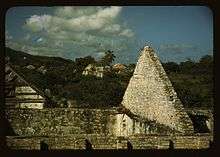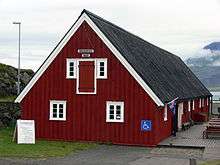Hans Jonatan
Hans Jonatan (1784–1827; also known as Hans Jonathan) was the subject of an important test case in Danish law on slavery. Fleeing to Iceland, he became one of the first people of colour to live in Iceland. Later, he became the subject of a groundbreaking DNA study.
Hans Jonatan | |
|---|---|
| Born | 1784 Saint Croix, Danish West Indies |
| Died | 1827 (aged 43) |
| Occupation | escaped slave, farmer |
| Known for | First person of colour in Iceland First person to have his genome reconstructed without use of physical remains |
| Relatives | Hansína Regína Björnsdóttir (great-granddaughter) |

Parents
Hans Jonatan was born a slave on the plantation at Constitution Hill on the island of St Croix in the Caribbean, which had become a Danish colony in 1733 when purchased by the Danish West India Company from France. His paternity is uncertain, but Pálsson argues in his biography that his father was a white Dane, Hans Gram, who was the secretary of his owners for three years; his mother was Emilia Regina, a black 'house slave' who is first recorded in 1773 at the St Croix plantation of La Reine, where she was presumably born. In 1788, Emilia had a daughter, Anna Maria, this time by a black man, Andreas, who at the time was a house slave too; but their fates are not recorded.[1] The details of the West African ancestry of Hans's mother were unknown prior to a genetic study.[2]
Hans Jonatan was owned by Heinrich Ludvig Ernst von Schimmelmann and his wife Henriette Catharina.
Life in Denmark
In 1789 the Schimmelmann family moved to Copenhagen as the plantation business took a downturn, bringing Emilia Regina and, later, Hans Jonatan with them. Not long afterwards, Heinrich died, bequeathing Hans to his widow Henriette Catharine. In 1801, at the age of seventeen, Hans Jonatan escaped and joined the Danish Navy. He participated in the Battle of Copenhagen, for which he received recognition. Danish crown prince Frederick gave him his freedom as a reward.
Subsequently, Henriette had Jonathan arrested, claiming that he was her property and that she had intended to sell him in the West Indies. Jonathan and his lawyer argued before a Copenhagen court under judge Anders Sandøe Ørsted (who would later become Prime Minister of Denmark) that although slavery was still legal in the Danish West Indies, it was illegal in Denmark and Hans Jonatan could not be kept as a slave. However, in the case Generalmajorinde Henriette de Schimmelmann contra mulatten Hans Jonathan 1802, Ørsted sentenced him on March 31, 1802 to be returned to the West Indies.[3][4]
Life in Iceland

Hans Jonatan escaped again, and his fate remained unknown to the Danish administration. It was only around the 1990s that the rest of his story was pieced together and started to become generally known. In 1802, he arrived in Djúpivogur in Iceland. One of the first records of Hans Jonatan after 1802 is in the diary of the Norwegian cartographer Hans Frisak for August 4, 1812:
- The agent at the trading post here is from the West Indies, and has no surname ... but calls himself Hans Jonatan. He is very dark-skinned and has coal-black, curly hair. His father is European but his mother a negro.
Frisak hired Hans Jonatan as a guide. Hans lived as a peasant farmer at Borgargarður working at the Danish trading station in Djúpivogur. He took over the running of the trading post in 1819.[3] By February 1820, Hans had married Katrín Antoníusdóttir from Háls. They had three children; two survived childhood, and their living descendants now number nearly nine hundred. Hans Jonatan died in 1827.
Genetic study
In 2018, scientists achieved a genetic breakthrough when they reconstructed a part of his genome solely using samples from his descendants and none from his remains. This was the first time that a human genome had been reconstructed without using physical remains. For the study, 788 of his descendants were identified, and DNA samples from 182 family members were taken. The study was aided by the extreme rarity of African heritage in Iceland, the homogeneity of the country's population, and its comprehensive genealogical database. The samples were analyzed against known signs of African DNA, recreating about 38% of his mother's DNA profile and thus 19% of his own. It was determined that his mother's ancestral origins were from a region now encompassing Nigeria, Benin, and Cameroon.[5]
Despite the popular tale of former prime minister Davíð Oddsson being Jonatan's descendant, no sources back up that claim.[6]
Biographies
A biography of Jonatan by Gísli Pálsson was published in Icelandic in 2014. An English edition titled The Man Who Stole Himself: The Slave Odyssey of Hans Jonathan was published in 2016.[7]
References
Citations
- Loftsdóttir & Pálsson 2013, pp. 41–44
- Jagadeesan, Anuradha. "Project 11: Computational reconstruction of Hans Jonatan's genome'". Retrieved 10 May 2014.
- Pálsson, Gísli (7 March 2009). "Hans Jónatan: karabískur þræll gerist íslenskur bóndi". Morginblaðið/Lesbók. Retrieved 10 May 2014. (in Icelandic)
- Loftsdóttir & Pálsson 2013, pp. 45–47
- Anuradha Jagadeesan and others, 'Reconstructing an African Haploid Genome from the 18th Century', Nature Genetics, 50(2) (2018), 199–205 doi:10.1038/s41588-017-0031-6.
- "Davíð Oddsson sagður afkomandi „dularfulla kynblendingsins" Hans Jónatans". DV (in Icelandic). 2019-01-17. Retrieved 2019-03-31.
- Palsson, Gisli (2016). The Man Who Stole Himself: The Slave Odyssey of Hans Jonathan. University of Chicago Press.
Sources
- Loftsdóttir, Kristín; Pálsson, Gísli (2013). Naum, Magdalena; Nordin, Jonas M. (eds.). "Black on White: Danish Colonialism, Iceland and the Caribbean". Scandinavian Colonialism and the Rise of Modernity: Small Time Agents in a Global Arena. New York: Springer. 37: 37–52. doi:10.1007/978-1-4614-6202-6_3.CS1 maint: ref=harv (link)